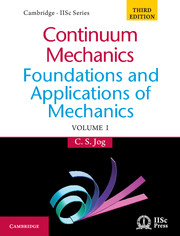1 - Introduction to Tensors
Published online by Cambridge University Press: 05 August 2015
Summary
In elementary physics, we often come across two classes of quantities, namely scalars and vectors. Mass, density and temperature are examples of scalar quantities, while velocity and acceleration are examples of vector quantities. A scalar quantity's value does not depend on the choice of the coordinate system. Similarly, although the componentsof a vector depend on a particular choice of coordinate system, the vector itself is invariant, and has an existence independent of the choice of coordinate system. In this chapter, we generalize the concept of a scalar and vector, to that of a tensor. In this general framework, scalars are considered as zeroth-order tensors and vectors as first-order tensors. Tensor quantities of order two and greater, similar to scalars and vectors, have an existence independent of the coordinate system. Their components, however, just as in the case of vectors, depend on the choice of coordinate system. We will see that the governing field equations of continuum mechanics can be written as tensorial equations. The advantage of writing the field equations in such ‘coordinate-free’ notation is that it is immediately obvious that these equations are valid no matter what the choice of coordinate system is. A particular coordinate system is invoked only while solving a particular problem, whence the appropriate form of the differential operators and the components of the tensors with respect to the chosen coordinate system are used. It must be borne in mind, however, that although using tensorial notation shows the ‘coordinate-free’ nature of the governing equations in a given frame of reference, it does not address the issue of how the equations transform under a change of frame of reference. This aspect will be discussed in greater detail later in this book.
We now present a review of tensors. Throughout the text, scalars are denoted by light-face letters, vectors are denoted by boldface lower-case letters, while second and higher-order tensors are denoted by boldface capital letters. As a notational issue, summation over repeated indices is assumed, with the indices ranging from 1 to 3.
- Type
- Chapter
- Information
- Continuum MechanicsFoundations and Applications of Mechanics, pp. 1 - 136Publisher: Cambridge University PressPrint publication year: 2015



